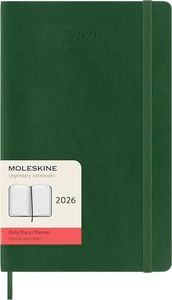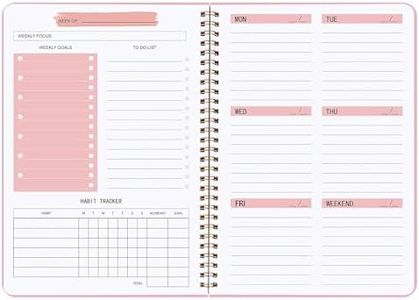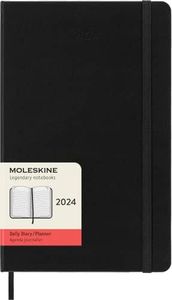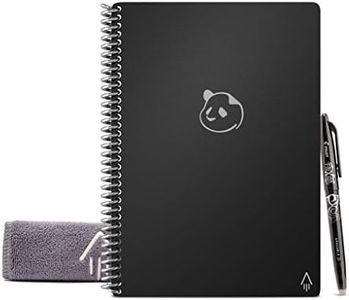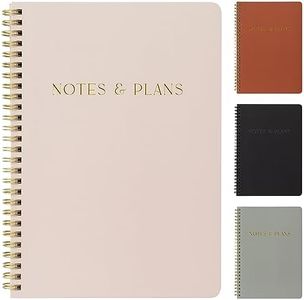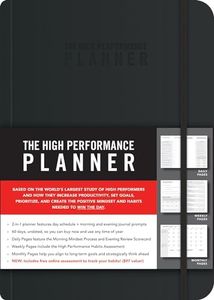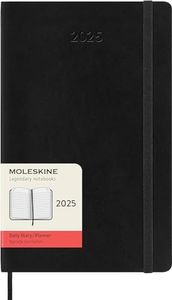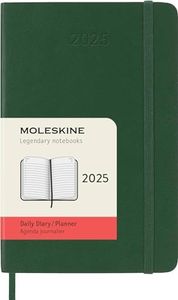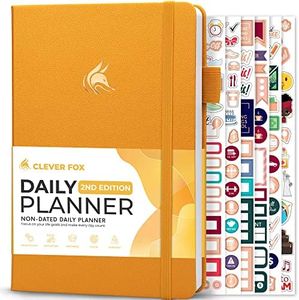We Use CookiesWe use cookies to enhance the security, performance,
functionality and for analytical and promotional activities. By continuing to browse this site you
are agreeing to our privacy policy
10 Best Daily Planners
From leading brands and best sellers available on the web.Buying Guide for the Best Daily Planners
Choosing the right daily planner comes down to understanding your personal planning habits, your organizational needs, and how you like to keep track of your schedule. With so many options on the market, it's helpful to focus on the most important features that affect usability, portability, and effectiveness. Knowing what each feature means and thinking about your daily life will help you make a choice that makes staying organized enjoyable and sustainable.LayoutThe layout of a daily planner refers to how the days and weeks are organized on each page. This is important because it directly affects how easy it is for you to see your schedule at a glance or make detailed plans. Common types include daily, weekly, and monthly formats. Daily layouts give you a full page per day, which is great if you have a busy schedule or want to include notes and to-do lists. Weekly planners show a week across two pages, good for seeing an overview and planning ahead. Monthly layouts are more compact, allowing you to mark major events and appointments. Think about how much space you typically need and how much you like to write each day to pick the right layout for your needs.
Size and PortabilitySize refers to how big or small the planner is, which determines how easily you can carry it with you. Larger planners have more space to write but are heavier and harder to fit in a bag, while smaller planners are easier to bring everywhere but may have less room. Consider where you usually plan: at a desk, in meetings, or on the go. If you value a lot of writing space and mostly plan at home or in the office, a larger size might work. If you need to carry your planner around all day, choose something lighter and smaller.
Binding TypeThis refers to how the pages of the planner are held together, affecting both durability and how easy it is to open the planner flat. Common types are spiral, hardcover, or softcover/glued. Spiral-bound planners lay flat easily and are simple to flip through, but the spiral can catch on things. Hardcover planners protect pages well and look professional, but may not open as flat. Softcover planners are lightweight and flexible but may be less durable. If you write a lot or need to lay your planner flat, consider spiral. If you want something sturdy for frequent handling, hardcover could be better; for the lightest option, go with softcover.
Dated vs. UndatedPlanners can come either pre-printed with dates or undated so you can fill in your own. Dated planners are helpful for people who want guidance and consistency, since you don’t have to write in the dates yourself. However, if you often skip days or want flexibility to start planning any time of year, an undated planner allows you to use pages as needed and prevents wasted space. Think about how consistent you are with planning—if you like structure, dated is easiest; if you take breaks from planning or want to avoid unused pages, undated is more forgiving.
Extra Sections and FeaturesExtra sections include things like goal trackers, habit trackers, budget pages, note sections, stickers, and pockets. These features add value and can help you keep all your important information in one place. If you like setting goals, tracking habits, or keeping receipts and loose papers, look for these extras. On the other hand, if you prefer a minimalist approach, choose a planner with fewer distractions. Consider what features would help you stay motivated and organized based on your personal habits.
Paper QualityThe thickness and texture of the paper affect your writing experience and whether ink bleeds through the pages. Thicker or higher-quality paper feels more pleasant and can handle different types of pens and markers. Thinner paper makes the planner lighter but may allow ink to show through. If you use fountain pens or markers, look for planners known for thick paper. If you only use pencils or ballpoints and want something lightweight, standard paper quality is usually enough.
